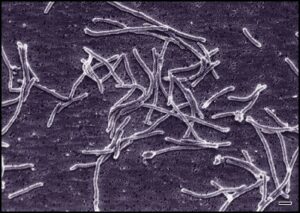In this post you will find the thermophilic bacteria examples, their importance and detailed facts.
Thermophiles or thermophilic bacteria are those who have affinity towards the high temperature. In simple words high temperature loving bacteria are called thermophiles. Their optimum temperature for growth is lies between 500C to as high as 1210C.
Thermophilic bacteria examples are:
- Thermus aquaticus
- Deinococcus radiodurans
- Thermus thermophilus
- Thermotoga maritima
- Geobacillus stereothermophilus
- Rhodothermus marinus
- Thermococcus atlanticus
- Geoglobus ahangari
- Sulfolobus acidocaldarius
Thermus aquaticus
Classification
- Domain: Bacteria
- Phylum: Deinococcota
- Class: Deinococci
- Family: Thermaceae
- Genus: Thermus
- Species:T.aquaticus
- Binomial name: Thermus aquaticus
Thermus aquaticus is a pretty common bacterium that can live in a lot of different environments, both natural and human-made.Thermus aquaticus can copy its DNA at high temperatures using its enzymes. Using Thermus aquaticus PCR becomes faster.
It is one of the extremophile that inhabits environments with very challenging conditions, places like deep sea vents.
Thermus aquaticus is used in polymerase chain reaction. Previously, the process is quite intensive so for each round of DNA copying in the old process of PCR, new enzymes are added.
Enzymes are proteins and heating them up usually breaks them down. . Until one researcher suggested trying out a DNA polymerase enzyme (Taq DNA polymerase) isolated from a bacteria that thrives in hot springs.
Example : Thermus aquaticus was first isolated from thermal springs in Yellowstone National Park (USA)

Deinococcus radiodurans
Classification
- Domain: Bacteria
- Phylum: Deinococcota
- Class: Deinococci
- Order: Deinococcales
- Family: Deinococcaceae
- Genus: Deinococcus
- Species: D.radiodurans
- Binomial name: Deinococcus radiodurans
As its name suggests it is one of the most potential extremophile who can tolerate extreme radiations. It also helps in the bioremediation of heavy metals especially those having radioactive property. Study shows that strain of D.radiodurans have the ability to form biofilms the remediation of uranium.
Thermus thermophilus
Classification
- Domain: Bacteria
- Phylum: Deinococcota
- Class: Deinococci
- Order: Thermales
- Family: Thermaceae
- Genus: Thermus
- Species: T.thermophilus
- Binomial name: Thermus thermophilus
It is aerobic and gram-negative bacterium having two strains (HB8 and HB27) whose complete genome sequence is available and used a model organism for systems biology. Strains of T.thermophilus are known to produce high amount of carotenoids. This property of biosynthesis of carotenoids may be due to presence of plasmids. This bacterium was first isolated in Japan from natural thermal environment.
Thermotoga maritima
Classification
- Domain: Bacteria
- Phylum: Thermotogota
- Class:Thermotogae
- Order: Thermotogales
- Family: Thermotogaceae
- Genus: Thermotoga
- Species: T.maritima
- Binomial name: Thermotoga maritima
It is an hyperthermophilic eubacterium isolated from heated marine environment. An anaerobic bacterium which is known to contain an encapsulin. Encapsulins are protein based bacterial nanocompartments found in bacteria and archaea which quite look like virion icosahedral particle. These encapsulins contain cargo enzymes (FLP-ferritin like protein) in their shell. These encapsulins facilitate isolation and catalysis of toxic substance in the cell.
Geobacillus stereothermophilus
Classification
- Domain: Bacteria
- Phylum: Bacillota
- Class: Bacilli
- Order: Bacillales
- Family: Bacillaceae
- Genus: Geobacillus
- Species: G. stereothermophilus
- Binomial name: Geobacillus stereothermophilus
It is gram-positive stain type and highly motile, aerobic in nature and produces spores that are resistant to heat. Its spores can survive upto 12 minutes at 1210C that is the reason it is widely used as biological indicator in testing and calibration of autoclaves in the industrial applications. This bacterium does not play any significant role in public health. It is also an important part of food industry.
Rhodothermus marinus
Classification
- Domain: Bacteria
- Phylum: Rhodothermota
- Class: Rhodothermia
- Order: Rhodothermales
- Family: Rhodothermaceae
- Genus: Rhdodthermus
- Species: R.marinus
- Binomial name: Rhodothermus marinus
It is gram-negative bacteria, quite halophilic and mostly thermophilic in nature. They are rods in shape, strictly aerobic. Enzymes present in R. marinus shows variations in activity in comparison to temperature. Like many of them shows optimum activity when there is preferably higher temperature than 650C.
Thermococcus atlanticus
Classification
- Domain: Archaea
- Phylum: Euryarchaeota
- Class: Thermococci
- Order: Thermococcales
- Family: Thermococcaceae
- Genus: Thermococcus
- Species: T.atlanticus
- Binomial name: Thermococcus atlanticus
It is coccus in shape and strictly anaerobic in nature. It is first found in hydrothermal vent of the mid-atlantic ridge. This bacterium needs protein rich substrates to grow, strain MA898 unusually grow in the presence of elemental sulphur, cysteine or polysulphur.
Geoglobus ahangari
Classification
- Domain: Archaea
- Phylum: Euryarchaeota
- Class: Archaeoglobi
- Order: Archaeoglobales
- Family: Archaeoglobaceae
- Genus: Geoglobus
- Species: G.ahangari
- Binomial name: Geoglobus ahangari
It is pleomorphic, anerobic isolated from Guaymas basin hydrothermal system. Strain 234T shows tumbling motility and are strictly anaerobic. The isolate is capable of growing with hydrogen without any need of carbon source.
Sulfolobus acidocaldarius
Classification
- Domain: Archaea
- Phylum: Thermoproteota
- Class: Thermoproteii
- Order: Sulfolobales
- Family: Sulfolobaceae
- Genus: Sulfolobus
- Species: S.acidocaldarius
- Binomial name: Sulfolobus acidocaldarius
It is the one of the archaebacteria which comes under the category of thermoacidophiles that can tolerate high temperature (800C) as well as low pH (upto 2). Sulfolobus grows in hot sulphur springs, they are facultative chemoheterotroph which oxidizes H2S to Sulphur and sulphur to sulphate.
Thermophilic enzymes and their potential roles
- Enzyme alpha- amylases of Thermoccus profundus DT5432 is widely used in starch processing and sugar industry.
- Enzyme beta-galactosidases of Pyrococcus woesei is used for the production of milk with low lactose content.
- Enzyme cellulases of Pyrococcus and Sulfolobales spp. are used in the ethanol and fruit industry.
- Glucose-6- phosphate dehydrogenase of Penicillium duponti helps in generation of NADPH for biosynthetic reactions.
- Alcalase of Bacillus licniformis helps in protein recovery from meat, fish and crustacean shell waste. It is used in fortified soft drinks and dietetic foods.
- Laccases of Myceliophthora thermophila polymerize the phenolic compounds to humic substances.
Importance
- They all are extremophiles that thrive under extreme conditions with high temperature, low pH, high salinity and high pressure.
- Bacteria isolated from these environmental conditions are widely used in biotechnological applications:
- Generation of biogas
- Thermophilic eznymes like taq DNA polymerase
- Restriction enzymes
- Bioleaching of poor mines
- Biosensors
- Thermophiles are used in bioconversion of lignocellulosic biomass to biofuels.
- Thermophilic microorganisms play important role in animal feeding environmental protection, human health and industrial applications.
- They are also used in the oil recovery at high temperature, salinity and pressure.
- They do bioremediation of persistent organic pollutants in the environment.
- They have excellent metal ion binding ability.
What are the reasons behind the survival of thermophiles at extreme conditions?
There can be many reasons which help the bacteria to survive at such high temperature:
- DNA is unstable at high temperature.Horizontal gene transfer (HGT) is one such mechanism of bacteria which provides the adaptation and thermotolerant abilities. An example is reverse gyrase enzyme which is transferred from archaea to bacteria. Reverse gyrase helps in supercoiling which result in lowering the melting temperature of DNA. So bacteria will start to grow slowly at higher temperature. Transfer of these genes from one bacteria to another through HGT will help in acquiring the same traits and become thermophiles.
- In most of the cases, it is seen that microorganism having high G+C content shows higher thermostability but it is not applicable to every microorganism.
- The arrangement of genes into operons are also seen as an important part of adaptation to temperature and environmental stress. Bacteria can respond to environment stress by regulating their operon system.
- Expression of gene in bacteria make different products like Heat Shock Protein (HSP) which responds by protecting against cell damage with extreme heat.
Also Read:
- Do bacteria have flagella
- Does mitochondria have double membrane
- Smooth endoplasmic reticulum function 2
- Tapeworms characteristics
- Are chromosomes eukaryotic
- Dna replication enzymes
- Chemiosmosis in chloroplasts
- Horseshoe crab example
- Fibrous protein function
- Aerobic respiration stages

Hi, I am Saif Ali. I obtained my Master’s degree in Microbiology and have one year of research experience in water microbiology from National Institute of Hydrology, Roorkee. Antibiotic resistant microorganisms and soil bacteria, particularly PGPR, are my areas of interest and expertise. Currently, I’m focused on developing antibiotic alternatives. I’m always trying to discover new things from my surroundings. My goal is to provide readers with easy-to-understand microbiology articles.
If you have a bug, treat it with caution and avoid using antibiotics to combat SUPERBUGS.
Let’s connect via LinkedIn: